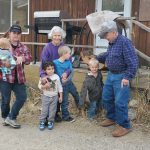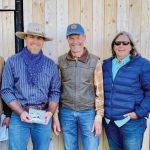
Community mourns the loss of a longtime veterinarian
Rancher’s Diary: Dr. Cope served his clients for 44 years, working right up until he died

Tips on when and how to check a cow when calving
It’s a combination of art and science to know when to assist in a birth without being too forceful

Why you should tune in to ‘Cows on the Planet’
Podcast is intended to inform non-farmers about what’s real in beef production

Important tips on birthing backward calves
You need to confirm their actual position before you start pulling

Winter conditions made it difficult to travel
Snow and cold weather for trips to buy bulls and pick up a mini excavator

Canadian visitors head back to Saskatchewan
After nice fall weather, winter shows up in mid November

Good weather persists, but rain needed
Dr. Cope makes one more ranch visit to preg-check cows

Low-stress handling techniques put to the test
Competition required competitors to apply many of the principles developed by Bud Williams

Tips for protecting hay quality over winter
Research shows single bale rows are better than a pyramid stack

Opportunity arrived to help a neighbour
Health issues seemed to dominate September, as the first frost of the season arrives

